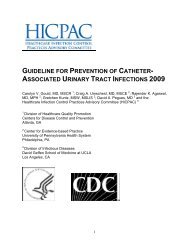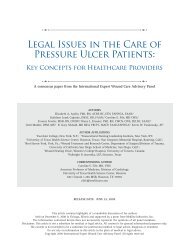SECT2.05 - Recommended Practices for Electrosurgery - Medline
SECT2.05 - Recommended Practices for Electrosurgery - Medline
SECT2.05 - Recommended Practices for Electrosurgery - Medline
- No tags were found...
You also want an ePaper? Increase the reach of your titles
YUMPU automatically turns print PDFs into web optimized ePapers that Google loves.
RP: <strong>Electrosurgery</strong>Reported November 25, 2003. http://www.accessdata.fda.gov/scripts/cdrh/cfdocs/cfMAUDE/Detail.CFM?MDRFOI__ID=499965. Accessed November 4, 2009.67. Center <strong>for</strong> Devices and Radiological Health. Manufacturerand User Facility Device Experience(MAUDE) Database Adverse Event Report 516905.Reported Feb ruary 16, 2004. http://www.accessdata.fda.gov/scripts/cdrh/cfdocs/cfMAUDE/Detail.CFM?MDRFOI__ID=516905. Accessed November 4, 2009.68. Manufacturer and User Facility Device Experience(MAUDE) Database. Adverse event report no.851317: Dispersive electrode. http://www.accessdata.fda.gov/scripts/cdrh/cfdocs/cfMAUDE/Detail.CFM?MDRFOI__ID=851317. Accessed November 4, 2009.69. Center <strong>for</strong> Devices and Radiological Health.Manufacturer and User Facility Device Experience(MAUDE) Database Adverse Event Report 286226.Reported July 6, 2002. http://www.accessdata.fda.gov/scripts/cdrh/cfdocs/cfMAUDE/Detail.CFM?MDRFOI__ID=286226. Accessed November 4, 2009.70. Center <strong>for</strong> Devices and Radiological Health.Manufacturer and User Facility Device Experience(MAUDE) Database Adverse Event Report 396295.Reported May 16, 2002. http://www.accessdata.fda.gov/scripts/cdrh/cfdocs/cfMAUDE/Detail.CFM?MDRFOI__ID=396295. Accessed November 4, 2009.71. Russell MJ, Gaetz M. Intraoperative electrodeburns. J Clin Monit Comput. 2004;18(1):25-32.72. Stecker MM, Patterson T, Netherton BL. Mechanismsof electrode induced injury. Part 1: theory. Am J ElectroneurodiagnosticTechnol. 2006;46(4):315-342.73. Patterson T, Stecker MM, Netherton BL. Mechanismsof electrode induced injury. Part 2: Clinical experience. AmJ Electroneurodiagnostic Technol. 2007;47(2):93-113.74. ECRI Institute. Higher currents, greater risks: preventingpatient burns at the return-electrode site duringhigh-current electrosurgical procedures. Health Devices.2005;34(8):273-279.75. Manufacturer and User Facility Device Experience(MAUDE) Database. Adverse event report no.1069874: REM PolyHesive II electrode, ESU, dispersive.http://www.accessdata.fda.gov/scripts/cdrh/cfdocs/cfMAUDE/Detail.CFM?MDRFOI__ID=1069874. AccessedNovember 4, 2009.76. Manufacturer and User Facility Device Experience(MAUDE) Database. Adverse event report no.907879: Generator. http://www.accessdata.fda.gov/scripts/cdrh/cfdocs/cfMAUDE/Detail.CFM?MDRFOI__ID=907879. Accessed November 4, 2009.77. Skin lesions from aggressive adhesive on Valleylabelectrosurgical return electrode pads. Health Devices.1995;24(4):159-160.78. MegaDyne Mega 2000 return electrode. HealthDevices. 2000;29(12):445-460.79. Center <strong>for</strong> Devices and Radiological Health.Manufacturer and User Facility Device Experience(MAUDE) Database Adverse Event Report 401617.Reported June 24, 2002. http://www.accessdata.fda.gov/scripts/cdrh/cfdocs/cfMAUDE/Detail.CFM?MDRFOI__ID=401617. Accessed November 4, 2009.80. <strong>Recommended</strong> practices <strong>for</strong> endoscopic minimallyinvasive surgery. In: Perioperative Standards and<strong>Recommended</strong> <strong>Practices</strong>. Denver, CO: AORN, Inc;2009:347-359.81. Greilich PE, Greilich NB, Froelich EG. Intraabdominalfire during laparoscopic cholecystectomy. Seecomment. Anesthesiology. 1995;83(4):871-874.82. Tucker RD, Voyles CR, Silvis SE. Capacitive coupledstray currents during laparoscopic and endoscopic electrosurgicalprocedures. Biomed Instrum Technol.1992;26(4):303-311.83. Wang K, Advincula AP. “Current thoughts” in electrosurgery.Int J Gynaecol Obstet. 2007;97(3):245-250.84. Shirk GJ, Johns A, Redwine DB. Complications oflaparoscopic surgery: how to avoid them and how to repairthem. J Minim Invasive Gynecol. 2006;13(4):352-359.85. Yazdani A, Krause H. Laparoscopic instrument insulationfailure: the hidden hazard. J Minim Invasive Gynecol.2007;14(2):228-232.86. Brunner LS, Suddarth DS, Smeltzer SCO, CheeverK, eds. Management of patients with intestinal and rectaldisorders. In: Brunner & Suddarth’s Textbook of Medical-Surgical Nursing. 11th ed. Philadelphia, PA: LippincottWilliams & Wilkins; 2008:1231-1281.87. McCarus SD. Physiologic mechanism of the ultrasonicallyactivated scalpel. J Am Assoc Gynecol Laparosc.1996;3(4):601-608.88. Ott DE, Moss E, Martinez K. Aerosol exposure froman ultrasonically activated (Harmonic) device. J Am AssocGynecol Laparosc. 1998;5(1):29-32.89. Matthews K. Argon beam coagulation. New directionsin surgery. AORN J. 1992;56(5):885-889.90. Fatal gas embolism caused by overpressurizationduring laparoscopic use of argon enhanced coagulation.Health Devices. 1994;23(6):257-259.91. Veyckemans F, Michel I. Venous gas embolism froman Argon coagulator. Anesthesiology. 1996;85(2):443-444.92. National Institute <strong>for</strong> Occupational Safety andHealth. NIOSH Hazard Control/Control of Smoke FromLaser/Electric Surgical Procedures-HC11. http://www.cdc.gov/niosh/hc11.html. Accessed November 4, 2009.93. ECRI Institute. Smoke evacuation systems, surgical.Healthcare Product Comparison System. 2007.94. Ball K. Lasers : The Perioperative Challenge. Denver,CO: AORN, Inc; 2004.95. Ulmer BC. The hazards of surgical smoke. AORN J.2008;87(4):721-738.96. Hoglan M. Potential hazards from electrosurgeryplume—recommendations <strong>for</strong> surgical smoke evacuation.Can Oper Room Nurs J. 1995;13(4):10-16.97. US Department of Labor Occupational Safety andHealth Administration. Safety and Health Topics: Laser/<strong>Electrosurgery</strong> Plume. http://www.osha.gov/SLTC/laserelectrosurgeryplume/index.html. Accessed November4, 2009.98. Alp E, Bijl D, Bleichrodt RP, Hansson B, Voss A. Surgicalsmoke and infection control. J Hosp Infect.2006;62(1):1-599. American National Standards Institute. Safe use oflasers in health care facilities. Orlando, FL: Laser Institute ofAmerica; 2005.100. Garden JM, O’Banion MK, Shelnitz LS, et al. Papillomavirusin the vapor of carbon dioxide laser-treatedverrucae. JAMA. 1988;259(8):1199-1202.2012 Perioperative Standards and <strong>Recommended</strong> <strong>Practices</strong> Equipment and Product Safety 117
















